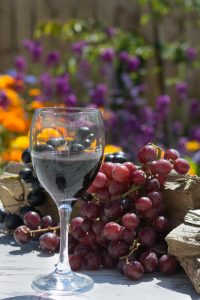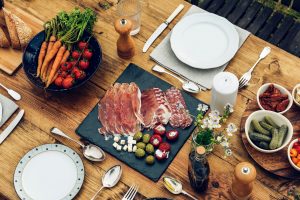What wine pairs well with fish? What is the difference between a red and white wine glass? What does a dry wine mean? These are common wine questions that a server may be asked at any point. This post will explore how to taste wine and communicate your experience and a wine's style with guests at your restaurant. After reading this post, you should feel confident in tasting wine and comfortable talking about the wines you pour in your restaurant. (Eds. Note: this blog post is best enjoyed with a glass of your favorite wine.)
How to Taste Wine
From commercials to the movie screen, everyone has seen the classic scene of a diner swirling their wine around the glass, then diving nose first into the glass to inhale the wine's secrets. For most, the order of these simple actions is irrelevant, but to a wine expert the steps for tasting wine are as important as the actions themselves. Below we break down the basic do's and don'ts of tasting wine.

The Swirl
DO: The first and most important step. Take the glass by the bottom of the stem and swirl! This will release the flavors and aromas of the wine.
The swirl also causes air to mix with the wine, which causes it to "open up" by allowing some of the alcohol vapors to dissipate. If you've ever used rubbing alcohol to sanitize a cut, you know how powerful a scent alcohol is.
By swirling, you cut down the impact of the alcohol smell and allow the more subtle aromas of the wine to shine.
DON'T: Swirl the glass for longer than 5 to 6 seconds, it isn't needed. Remember it's a glass of wine, not a mixed drink.
While it can seem rudimentary (or even cliché), swirling is essential. To see for yourself, just take a sip of wine before swirling it. Then, cleanse your palate with some water, swirl the wine like a Frenchman, and take another sip. Take note of what's changed.
The difference in aromas and flavors is nearly impossible to miss! So don't forget to swirl! When serving, it might even be helpful to give this tip to your guest and quickly explain the benefits. Not only will it increase their wine experience, but it will also make you appear very knowledgable.
 The Smell
The Smell
DO: Stick your nose in it! Not literally, but knowing what the wine smells like will help you pair the wine with food. Note the first things the wine reminds you of. Is it fruity, flowery, herbal, spicy, buttery?
Don't: Taste the wine before smelling it. The wine aroma is important to the experience of tasting, so get to the know the smell before the taste.
The Taste
First impressions matter. And once the wine has introduced itself to you with smell, then you can take your findings from the first steps and you are finally ready for the best part, tasting!
DO: Take a small sip of the wine, lightly swish it around your mouth, and swallow. This warms up the wine and enhances the wine's flavor profile.
While the wine is swishing in your mouth, breath steadily through your nose. This activates your sense of smell which is a big part of tasting and allows your taste buds to be more perceptive.
DON'T: Gulp! The worst way to taste wine is by chugging it. This method means you won't have the opportunity to enjoy the full experience of the complex flavors wine has to offer.
Wine Tasting Glasses
The most important aspect that all wine glasses share is the stem. A wine glass is designed so the glass can be held by the stem and not the bowl. Holding the wine by the base of the bowl can change the temperature of the wine and impact the taste even before you have a chance to drink it. This also explains why it is important to serve wine by the stem and not by the bottom of the bowl.
 Red Wine
Red Wine
Red wines are typically served in taller glasses with a wider opening and larger bowl.
This allows for more oxygen to interact with the wine. What does air do? Well, remember the importance of the swirl in tasting? The more oxygen that interacts with red wine causes the flavors and aromas of the wine to become more apparent. This allows for a full and flavorful wine drinking experience.
Bold Flavor
Red wines are typical more robust, with bigger flavor than white wine. The interaction of grape skin and grape juice during the red wine making process provides more depth in flavor, a depth that requires more air to mingle with the wine so the flavors can be enjoyed.
Balancing Flavor
The skin contact of red wine making also results in some unwanted flavors, like tannins. While some tannins are good for wine, and even desired by some wine drinkers, the bitter flavor compounds can be too intense and overpower the more restrained flavors of the wine. The larger glass allows some of these bitter, unwanted flavors to be minimized so the wine has a smoother mouth feel.
Shape Shifting
Even within the category of red wines, there are difference in glass type depending on the style of red wine.
Burgundy Glass: A burgundy red wine glass has a large bowl, shaped like a balloon cut in two at the midsection. The burgundy glass can be thought of as the preferred shape for lighter style red wines. The large bowl helps capture the more subtle aromas and allow more air interaction so the overwhelming flavors like tannins and be reduced.
Bordeaux Glass: A Bordeaux red wine glass is has taller bowl than its burgundy brother, with sides tat are more straight. If a burgundy glass has a globular shape, than the Bordeaux glass is a cylinder. The straight sides cause the heavier, bold wine to be poured right to the back of the tongue, where taste buds are concentrated so the full flavor makes a full impact. The height of the bowl also allows oxygen to interact with the wine as it moves from the bowl to the glass.
White Wine
Unlike reds, for white wine you don't want to have as much interaction with oxygen. As a result glasses for white wine are narrower with smaller openings. This is because white wines have much more subtle flavors than red wines. Citrus and floral notes are more represented in white wine styles than red, and these flavors are more ephemeral and delicate.
Additionally, white wine generally has a lower alcohol content than red wines. This isn't a rule, but more of a generality. The alcohol volume in a wine (and all alcohol) is determined by the amount of sugar present at fermentation. Sugar is converted to alcohol by yeast. Red wine grapes are generally left on the vine longer than white wine grapes, which allows more sugar to develop during growth before the grapes are harvested.
With a lower alcohol content, there is less need to evaporate alcohol vapors for the subtle flavors and aromas to be detected.
Sparkling Wine & Champagne
Sparkling wine and Champagne is commonly served in a flute, a glass with a long stem and a tall slender bowl. This glass preserves the drinks carbonation by reducing the its ability to escape. The shape keeps the bubbles in the bubbly.
And though the Champagne saucer is still used today, with its shorter stem and shallow, UFO-shaped body, it's more a novelty that captures the extravagance of the roaring twenties than it is a practical vessel for sparkling wine. The wide mouth and shallow bowl cause oxygen to deplete the bubbles and take the fizz away from Champagne, leaving you with a flat and lifeless glass of wine.
Wine Pairings
Technically wine can be paired with anything and is ultimately up to the guest. However, as a server you will be asked for your recommendations quite frequently. The list below gives you the basics on the best wine and food pairings to optimize taste!

Dry White
A rule of thumb is that fish pairs well with white wine. This allows for the guest's preferences to determine if they would like a dry white wine or a sweet wine. Dry white wines pair perfectly with vegetables, fish, and even creamy sauces. Examples: White Table Wine, Sauvignon Blanc, Pinot Grigio
Sweet White
Sweet white wine pairs well with soft (i.e. brie) and hard cheeses, cured meat, and creamy sauces. This is the perfect option for charcuterie platters.Examples: Reisling, Mosacto
Rich White
Beyond pairing well with cheeses and fish, rich white wines go great with poultry. For instance grilled chicken dishes and even pasta dishes that contain chicken. Examples: Chardonnay, Viognier
Sparkling
Champagne isn't just for celebration and can pair well with fish, vegetables, cheeses, and even eggs. Examples: Champagne, Processo, Sparkling Wine

Light Red
Another rule of thumb is red wine and red meat are always a go to pairing. Suggesting Filet Mignon specifically pairs really well with light red wine. Examples: Pinot Noir
Red
Along with red meats it also pairs well with cured meats. Examples: Cabernet Sauvignon, Merlot,
The different pairings demonstrate that their is a lot of overlap with the pairings of various wines. The main takeaway is that fish pairs well with white and red wine pairs well with red meat. It would be a good idea to have a few pairing up your sleeve that are more specific to your restaurants menu. This allows you to always be prepared with stellar recommendations for your guest.
Basic Wine knowledge
Below are some of the basic terms that every wine expert needs to know.
Terms
- Acidity: Present in all grapes and play a role in the preservation of the wine. Wines that have a sharper and more crisp taste will have higher levels of acidity.
- Aperitif: A dry wine served before a meal that is used to stimulate the appetite.
- Appellation: The area that the grapes are grown that are used to make a particular wine. There are normally guidelines in place to ensure that wines give the name of an appellation have a certain percentage of grapes included in the process of making the wine.
- Body: A term used to describe the flavor profile of a wine. For instance a full-bodied wine is one with a powerful flavors and strong aftertaste.
- Brut: A term used to describe dry Champagne and sparkling wines.
- Decanting: Pouring wine into a separate container before serving in a wine glass. This seperates in sedimant present and also enhances the aromas and flavors of the wine by increasing its interaction with oxygen. Normally done to younger bottles of red wine before a tasting.
- Dry: Wine that normally consist of very little to no sugars.
- Finish: A term used to describe the after taste of a wine. The flavor that you experience after you finish taking a sip.mature
- Mature: Considered a good quality wine that is older. Wine has the ability to improve with age so more mature wines are considered to have a greater quality.
- Oxidize: Occurs when wine interacts with oxygen and can change the flavor profile of the wine.
- Regional: Wines that are named after the region that they are produced in. One common regional wine are Bordeaux and Burgundy wines. Both are actually regions in France that the different brands of wine are produced.
- Sediment: Yeast cells, pieces of grapes, among other substances that play a role in making wine that can sometimes be found in a bottle.
- Sweet: Wine can come in various levels of sweetness and it all depends on how the wine was made. The sweeter the wine the more sugar. Knowing the sweetness of a wine can play an important role in successfully pairing wine. For instance sweet white wine pairs well with pastas with creamy sauces.
- Varietal: Wine that has been named after the grape that it consist of. For example, Chardonnay and Merlot are all named after the grape used to produce it.
- Vintage: A Vintage wine is one where all of the grapes used in the creation of the wine were grown in the same year.
With these tips and tricks you are now able to take on wine and most obstacles you might face when serving!
-1-1.jpg?height=400&name=adult-celebration-drink-696219%20(1)-1-1.jpg)


